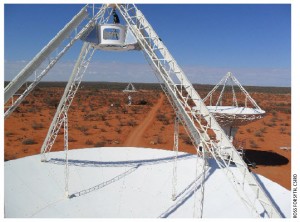
Star gazers, both professional and amateur, are closely following progress in one of the great global science projects of the 21st Century, the Square Kilometre Array (SKA). It’s a radio telescope being developed by a global collaboration of 20 countries, including Canada, and it promises to revolutionize our understanding of the universe through new insights into physics and astronomy.
The scientific dimensions of the SKA are remarkable. Its several thousand antennas will have a total collecting area of approximately one square kilometre and make the SKA 50 times more sensitive than any other radio instrument. And it will be able to survey the sky more than 10,000 times faster than ever before.
The governments of Australia and New Zealand have united in a bid to host the SKA in our two countries, with a proposed core site in a sparsely populated region of the state of Western Australia. With a configuration of receiving stations extending 5,500 kilometres to New Zealand, the SKA will deliver the highest resolution images in all astronomy.
The SKA will enable science to address fascinating questions. By mapping a billion galaxies out to the edge of the universe, it will allow researchers to determine the processes by which galaxies formed and grew. It will also be able to fill in the gap — known to astronomers as the “dark ages” — between 300,000 years after the Big Bang (when the universe became transparent) and a billion years later when young galaxies were first sighted. The SKA can also detect extra-terrestrial radio wavelength emissions, and may even be able to spot other planets capable of supporting life.
The winning bidders — South Africa is also vying for the honour on behalf of the Southern African region — will be chosen by an international SKA steering committee of representatives from national funding and scientific agencies later this year or early next.
Contruction of the SKA, the cost of which is still being calculated, is scheduled to begin in 2016, with the first observations expected by 2019. The location of the SKA will be crucial to delivering high-quality results and it is of pivotal importance that the telescope array, particularly the core site, be located in unpopulated areas with low levels of man-made radio interference.
The project enjoys bipartisan support in both Australia and New Zealand, and we want to ensure that researchers worldwide are able to make the most of the opportunities that will flow when the telescope is up and running.
The SKA requires a high level of collaboration between scientists from around the world. The University of Calgary is at the forefront of Canada’s involvement, and engineers at the University’s Schulich School of Engineering are charged with designing the SKA’s roughly 20 million receivers, in collaboration with scientists and engineers nationwide including those at the National Research Council’s Herzberg Institute of Astrophysics.
Canada will also host the 2011 International SKA Forum, scheduled for July 6 in Banff, Alta. — the first time the forum has taken place in North America. This annual event brings together the scientific community, government and industry to raise the profile of the SKA and make decisions on its development.
The Australian and New Zealand joint bid proposes that the core site be located in the Shire of Murchison in Western Australia, one of the most sparsely inhabited areas on Earth. The Shire of Murchison covers an area roughly the size of the Netherlands but is home to only 110 people. This low population makes the area almost radio silent and increases the flexibility to place antenna stations on or near ideal sites.
Our governments are already working together to develop new radio astronomy infrastructure. In May, six radio telescopes across Australia and New Zealand linked up over a distance of 5,500 kilometres to act as one giant telescope, using the region’s extensive broadband infrastructure. This will be a valuable asset for the SKA should our bid be successful, and promises to reduce the cost and complexity of building the SKA at our proposed site.
We achieved another milestone in October when we built five new antennas for the SKA Pathfinder radio telescope — an important demonstration of the project’s future technology. The five antennas will join the first SKA Pathfinder antenna, successfully built and tested earlier in the year at the Murchison Radio-Astronomy Observatory. A total of 36 antennas are due for completion by 2013.
Preparation for the SKA is progressing quickly, and governments around the world will be involved in the site-selection process. With ongoing commitment to investing in leading-edge research, Australia and New Zealand have based their bid to host the SKA on a shared record of excellence in radio astronomy.
We believe our proposal will allow the SKA to realize its full potential. This means maximizing the benefits for all countries — not only in astronomy, but also in applications for green energy and high-tech communications that will benefit generations to come.





